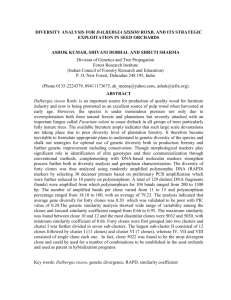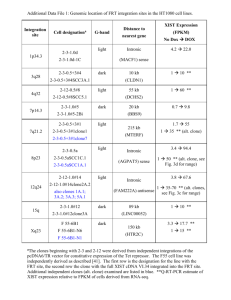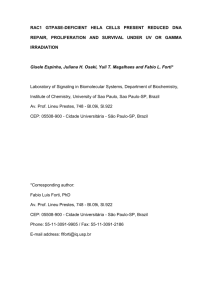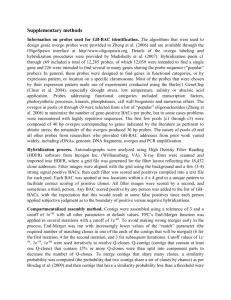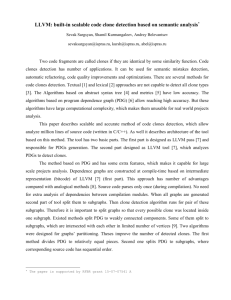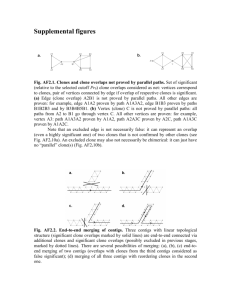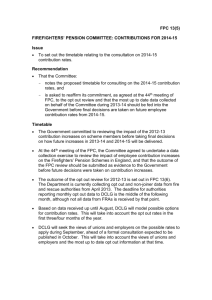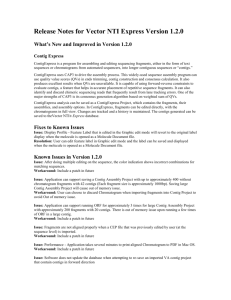Software for Restriction Fragment Physical Maps
advertisement
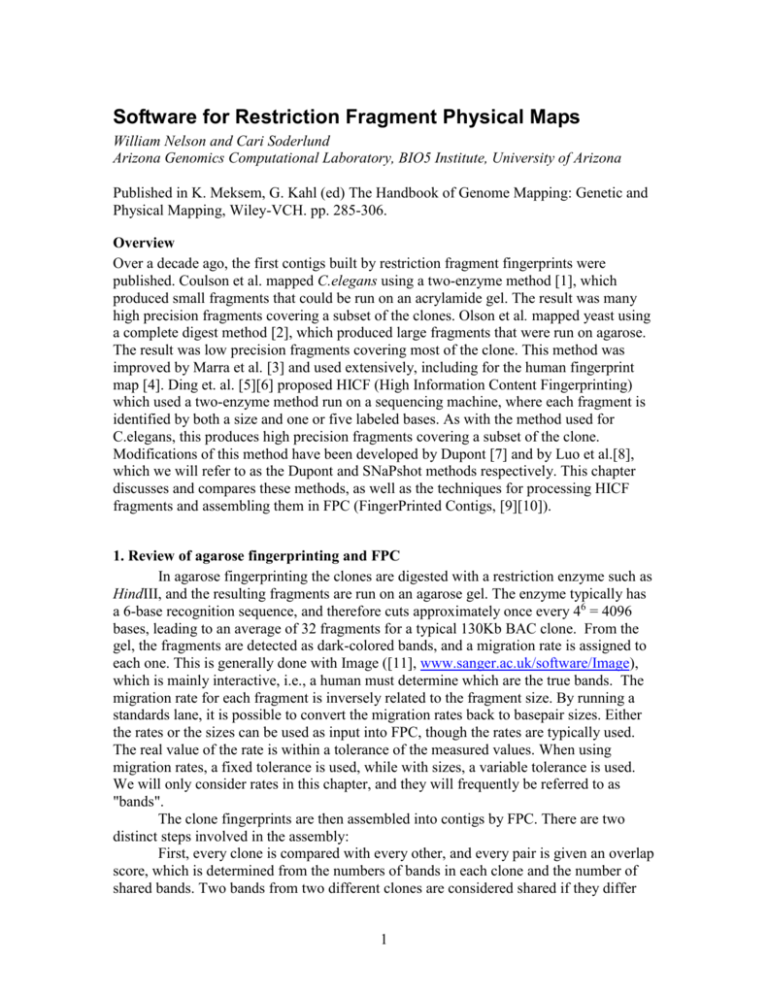
Software for Restriction Fragment Physical Maps William Nelson and Cari Soderlund Arizona Genomics Computational Laboratory, BIO5 Institute, University of Arizona Published in K. Meksem, G. Kahl (ed) The Handbook of Genome Mapping: Genetic and Physical Mapping, Wiley-VCH. pp. 285-306. Overview Over a decade ago, the first contigs built by restriction fragment fingerprints were published. Coulson et al. mapped C.elegans using a two-enzyme method [1], which produced small fragments that could be run on an acrylamide gel. The result was many high precision fragments covering a subset of the clones. Olson et al. mapped yeast using a complete digest method [2], which produced large fragments that were run on agarose. The result was low precision fragments covering most of the clone. This method was improved by Marra et al. [3] and used extensively, including for the human fingerprint map [4]. Ding et. al. [5][6] proposed HICF (High Information Content Fingerprinting) which used a two-enzyme method run on a sequencing machine, where each fragment is identified by both a size and one or five labeled bases. As with the method used for C.elegans, this produces high precision fragments covering a subset of the clone. Modifications of this method have been developed by Dupont [7] and by Luo et al.[8], which we will refer to as the Dupont and SNaPshot methods respectively. This chapter discusses and compares these methods, as well as the techniques for processing HICF fragments and assembling them in FPC (FingerPrinted Contigs, [9][10]). 1. Review of agarose fingerprinting and FPC In agarose fingerprinting the clones are digested with a restriction enzyme such as HindIII, and the resulting fragments are run on an agarose gel. The enzyme typically has a 6-base recognition sequence, and therefore cuts approximately once every 46 = 4096 bases, leading to an average of 32 fragments for a typical 130Kb BAC clone. From the gel, the fragments are detected as dark-colored bands, and a migration rate is assigned to each one. This is generally done with Image ([11], www.sanger.ac.uk/software/Image), which is mainly interactive, i.e., a human must determine which are the true bands. The migration rate for each fragment is inversely related to the fragment size. By running a standards lane, it is possible to convert the migration rates back to basepair sizes. Either the rates or the sizes can be used as input into FPC, though the rates are typically used. The real value of the rate is within a tolerance of the measured values. When using migration rates, a fixed tolerance is used, while with sizes, a variable tolerance is used. We will only consider rates in this chapter, and they will frequently be referred to as "bands". The clone fingerprints are then assembled into contigs by FPC. There are two distinct steps involved in the assembly: First, every clone is compared with every other, and every pair is given an overlap score, which is determined from the numbers of bands in each clone and the number of shared bands. Two bands from two different clones are considered shared if they differ 1 by less than the tolerance, which is a user-supplied parameter to FPC. The score for a pair is intended to be roughly the probability that those two clones would share that many bands by random chance; the lower the score, the more likely it is that the two clones actually overlap in the genome. FPC compares the score against another user-supplied parameter, the cutoff, and if the score is lower, FPC puts those two clones into the same contig. After FPC joins the clones into contigs, it tries to determine their ordering within the contigs. For this purpose, FPC computes a "consensus band map", or CB map. Ideally, the CB map lists in the correct order all of the bands in the stretch of genomic DNA covered by the contig. In practice, the clone band files contain numerous errors, including extra bands, missing bands, and incorrectly sized bands, which make it impossible to compute an exact CB map. Also, contigs can be wrongly joined by a falsepositive overlap, meaning that even with perfect data, a good CB map could not be generated since the contig actually covers two or more disjoint pieces of DNA. To compute the best solution would take an unacceptable amount of computer time, therefore, the algorithm to build the CB maps is an approximation. FPC makes several attempts to compute a CB map (the exact number is user-specified), each time starting from a different initial clone. Each attempted CB map gets a score, which reflects the fraction of the clone bands which actually align to the map; bands which do not align are referred to as "extra" bands. A clone that contains more than 50% extra bands is labeled as a "Q" (for question) clone. Generally, the presence of more than a few Q clones indicates that a contig has at least one false positive overlap and should be broken into two or more contigs (this is further discussed in Section 4.5.). FPC chooses the best-scoring CB map for each contig, and records the number of Q clones in each contig. These numbers are shown to the user, who can then choose to run the "DQer" to reduce the number of Q clones. The DQer attempts to break up contigs having more than a given (user-specified) number of Q clones, by re-running the assembly algorithm on those contigs using more stringent cutoff values. Specifically, it re-runs the algorithm up to three times, each time with the cutoff reduced by a userspecified step. For example, if the cutoff is set at 1e-12, and the step is set to 1, then all contigs with too many Q clones will be re-evaluated at 1e-13. This may split some contigs apart, hopefully eliminating the bad joins and reducing the Q count. Contigs which still have too many Q clones will then be re-evaluated at 1e-14, and again if necessary at 1e-15. This is the procedure followed to build an agarose map. We now discuss the exact values of the parameters appropriate for agarose projects, in order to compare to the HICF projects discussed next. The tolerance is determined by how accurately the gel image can be scored by bandcallers; typically, a value of 7 is used (which corresponds very roughly to 15bp). In these units, the range of possible band sizes is approximately 500-1900, so the "gel length" parameter should be 1400. Gel length is an important parameter because it determines the probability of two random bands overlapping to within the tolerance; for example, two bands picked randomly from a range 500-1900 are much more likely to be within 7 of each other than two bands picked from a range 10 times as large. We note that the default gel length on FPC is 3300, which is the value that has been used in most agarose projects. This value is considerably larger than the "correct" 2 value of 1400, which means that the score cannot really be interpreted as a probability (and this interpretation was already somewhat problematic due to factors discussed in Section 5.2 below). The success of these projects indicates that the score can function successfully as a coincidence score even if it loses its strict interpretation as a probability; in fact, it is often referred to as a concidence score. The best cutoff to use is influenced by two factors. First is the size of the project. The more clones a project has, the more opportunities there are for false overlaps to occur strictly by random chance, and the cutoff needs to be low enough to exclude these false overlaps. Second, since the genome is not random, there are repeated bands which cause clones to share more bands than they would randomly. Because of this, the cutoff has to be lower than it would otherwise be, to avoid false-positive overlaps. But since the presence of many Q clones provides a way to detect most false positives [10], the cutoff does not have to be low enough to completely eliminate these two factors, and instead the DQer can be run to reduce the false positives. For agarose projects using BAC clones, with gel length 3300, a cutoff of 1e-12 generally gives good results (with subsequent execution of the DQer). The cutoff determines the approximate percentage overlap that two clones must have in order to be joined, and this in turn determines the expected numbers of contigs and gaps. For example, with tolerance 7 and gel length 3300, a cutoff of 1e-12 means two 30-band clones must share at least 21 bands to be joined (calculated from the Sulston overlap formula, [12]). In other words the clones must overlap by at least 70% in order to be joined. Letting θ denote the required overlap percentage, c the coverage, and N the total number of clones, then the expected number of contigs is approximately Ne c (1 ) [13]. Since this number depends exponentially on θ, it is very desirable to reduce θ as much as possible, as even a small decrease translates into a significant reduction in the necessary coverage multiple. The 70% value typical of agarose projects seems quite high, and one of the primary goals of HICF is to lower this number. Besides the 70% overlap requirement, the other major disadvantage of the agarose method is the necessity of human bandcalling. Human bandcalling is very timeconsuming, requiring about 45 minutes per 96-clone plate, and it is also quite prone to error. 2. HICF Techniques 2.1. Generalities HICF fingerprinting applies to physical mapping the same technology which has given rise to high-throughput sequencing. In HICF, the clones are digested with restriction enzymes that result in an overhang on one or both ends, and then labeled with one or more fluorescent labels which attach to the overhanging bases. The labels will have different colors depending on the nucleotide they attach to, so that the color (or colors) of a fragment directly correspond to nucleotides of the overhang (an exception to this rule is the original method of [5]). The fragments are run in a sequencing machine, which determines their sizes and colors, without laborious human bandcalling. Fragments from different clones are considered to match if their sizes differ by less than the tolerance, and their color labels are the same. 3 HICF techniques can be divided into two types, according to whether one or multiple bases are labeled on the overhang. The multiple-base labeling methods are really small sequencing reactions in which the overhang of each fragment is sequenced. Clearly this would add greatly to the information content of the fingerprints, if it were practical; however, the analysis of the sequencer output becomes quite difficult in this case, and to our knowledge only single-base labeling has so far been used in practice. Even with single-base labeling, a fragment can sometimes have more than one label. This cannot be avoided because inevitably some fragments will be cut on both ends by the enzyme that gives an overhang, and the overhangs on each end will be labeled. If the two labels have different colors, the fragment will be detected as two fragments, having different colors but the same size. Whether these should be treated as one fragment or two is discussed further in Section 5.2. In addition to being more automated, HICF is also much more sensitive than agarose, for two reasons. First, the fragment sizes are determined to a very high precision, generally giving at least a .3bp precision (the meaning of fractional basepairs will be discussed below). This means that when fragments do match up to within this tolerance, it is less likely to be by chance, so a smaller number of matches is needed to identify a true overlap. Second, there are generally more fragments than in agarose, typically around 100 per clone. More fragments mean more information, which is an advantage as long as there are not so many that they start to randomly match up. With HICF, the high precision plus the use of different color labels to further distinguish fragments means that many more fragments can be used without an unacceptable number of false matches. Because of this extra sensitivity, HICF is theoretically capable of discriminating much smaller clone overlaps than agarose; for example, a cutoff 1e-12 requires only about 30% clone overlaps with typical HICF parameters. This is a tremendous gain in efficiency, although in practice non-randomness of the DNA and the error rate can prevent one from actually using such small overlaps. In the highly repetitive maize and wheat genomes, which have so far been the main subjects of HICF, cutoffs in the range 1e-25 to 1e-50 have been found to be necessary. One drawback to HICF, which we will discuss below, is that the HICF bands can not be accurately reproduced in silico, meaning that sequenced clones can not be mapped back to the physical map. This is unfortunate because placing sequenced clones on the physical map has proved very useful with agarose maps [14]. A second drawback is that the fragments only cover a subset of the clone so the fragments can not be used to approximate the size of the clones, which has been useful in the agarose method. Several variants of HICF have been proposed in recent years, beginning with [5]. This approach required three separate labeling reactions for each clone, and was improved upon in [6] with a method based on a Type IIs restriction enzyme. This method was adapted by Dupont [7] and will be described in Section 2.2. Another promising variant [8], based on the ABI SNaPshot kit, is described in Section 2.3. 2.2. Approaches using Type IIs enzymes Ding et. al. [6] proposed that the DNA be cleaved by the Type IIs 5-cutter enzyme HgaI into fragments with 5-base pair overhangs. The fragment sizes were further reduced by digestion with the Type II 4-cutter enzyme RsaI, which produces blunt ends. 4 This second enzyme is necessary to produce small enough fragments to be run on a sequencing machine. The fragments having an overhanging end were then labeled with either one or five fluorescent labels, and run through an ABI 377 sequencer to detect their labels and sizes. (Note that most of the resulting fragments are cut on both ends by the 4cutter, and therefore are not labeled at all. These fragments are discarded and do not contribute to the fingerprint.) Ding et. al. [6] also developed a technique, as described below, which allows HICF data to be used directly within FPC. Dupont has developed a slight modification of this process [7], which we will refer to as the "Dupont" method. In this method, the Type IIs enzyme is the 6-cutter EarI, while the Type II is the 4-cutter TaqI. In contrast to the Ding method, the 4-cutter cuts with a two-base overhang, where the first base is g. Since the 4-cutter cuts very frequently, the base g is not labeled; hence there are only three color labels in the Dupont method, as opposed to four in the original. Also, this method uses only single-base labeling, even though EarI has a three-base overhang. Dupont has applied this method to construct a complete map of the maize genome using the ABI 377 sequencer. They have reported a significantly smaller number of contigs for the same clone count as compared to the public agarose map; however, their map has not been made public. Based on this positive report it was decided that a publicly available maize HICF map should be constructed using the Dupont method. This work is being done at Rutgers and the University of Arizona by a group which includes the present authors (see http://www.genome.arizona.edu/fpc_hicf/maize/). We are using the same enzyme set as Dupont, but we chose the ABI 3700 sequencer instead of the 377 in order to increase throughput. We have also found it necessary to build with lower cutoffs (1e-45 - 1e-50) than those reported by Dupont, but it is difficult to resolve this discrepancy since the Dupont data is not available. For this process, we see approximately 17% error; in other words, approximately 17% of the bands in the final band files appear to be incorrect. This means that two identical clones, prepared separately and fingerprinted on different machines, will have only 66% of their bands overlapping on average, and it does not appear possible to correct this through data processing. 2.3. SNaPshot HICF The SNaPshot process was developed by Applied Biosystems for analyzing SNPs, and has been adapted for fingerprinting by Luo et. al. [8], who used it construct a physical map of wheat genome D (the NSF Wheat D Genome Project, http://wheatdb.ucdavis.edu:8080/wheatdb; see also [15]). In SNaPshot, clones are digested with four 6-cutter Type II enzymes (EcoRI, BamHI, XbaI, XhoI), and one 4cutter (HaeIII) whose purpose is again to reduce the fragment sizes. The four enzymes are chosen so each one has a unique first base on its overhang, meaning that after labeling, the four colors correspond cleanly to ends produced by the four enzymes. Since the Type II cut sites lie within their recognition sequences, the sequences surrounding the labeling sites are determined, which may lead to more consistent labeling in this method as compared to Type IIs methods. It does appear that noise is reduced in SNaPshot, leading to a higher-quality build. In tests carried out as part of the NSF Wheat D Genome 5 Project, the error rate per fingerprint was measured at just over 13% (Frank You, pers. comm.), a significant improvement over the 17% rate which we measured for Dupont HICF. However, a conclusive comparison of the two techniques has not been carried out. SNaPshot is currently not supported on 3700 machines, but it is supported on the 3730 and 3100, so high-throughput fingerprinting is possible. 3. Processing HICF data 3.1. Peak scoring The HICF data comes from the ABI sequencing machine in the form of a "trace" file, with extension .fsa. This file contains a graph of the intensity recorded for the different colors as a function of time (an "electropherogram"), which is the raw output of the machine. As a fragment goes by the detector, it produces a peak in the graph corresponding to its color label. The goal is to locate these peaks, separate the real ones from spurious ones, and figure out the size (in basepairs) of the fragments which produced them. If the ABI Genescan Analysis software is set to "auto-analyze", then the software will carry out some of these steps automatically. In particular, it will locate the peaks and assign fragment sizes to them. The peaks, along with their heights, widths, and fragment sizes, are entered into a table known as the "peak table", which is also contained in the trace file (Fig. 3.1). With current size standards, the fragments can be sized from 35500bp. 6 Fig. 3.1. Display of an HICF fingerprint in Genescan, showing electropherogram and peak table for the blue channel. Unfortunately, several hurdles remain. First, the peak table contains many spurious peaks, sometimes hundreds, from which the real peaks must be separated. Generally this is done using a threshold scheme - the real peaks are assumed to be higher than the false ones, so a threshold is chosen and peaks below the threshold are discarded. However, choosing the threshold is not so easy. A fixed threshold does not work because the overall strength of the signal can vary dramatically from trace to trace, and from color to color. Sometimes the highest peaks will be under 1000, sometimes they will be 10,000 or more. Because of this variability, usually one or more of the higher peaks are used to normalize the height scale; for example, in our maize project, for each color we take the 6th highest peak of that color, and multiply its height by .25 to get the threshold for that color. Dupont used a similar scheme, and the GenoProfiler application (discussed below) also implements this idea, with user-specified parameters [16]. Obviously this kind of thresholding scheme has a number of adjustable parameters, which need to be optimized on some control data. In our project, we fingerprinted a set of clones repeatedly and chose the parameters which gave the best match of the replicates; however, we saw approximately equal performance for factors from .2 to .4, and it seems unlikely that there is one "best" parameter set. A complication present with the 3700, and possibly other capillary-based sequencers, is so-called "front-end loading", which results in spurious peaks at sizes below 75bp. This problem is most easily resolved by not using fragments smaller than 75bp. 3.2. Sizing of fragments The sizing of fragments is carried out by Genescan software, and it is very consistent. For example, we found a maximum standard deviation of .15bp for six identifiable vector bands, measured across five different 3700 machines and approximately 60,000 clones. This consistency allows the use of quite low tolerances for building HICF fingerprints within FPC, as compared to agarose. Unfortunately the sizes, although highly consistent, are not very accurate. This has been observed by all HICF groups and is recognized by ABI as well. The error is typically 0-6bp, up or down; for example, a fragment of actual size 100bp can give rise to a peak anywhere from about 94-106bp. There is no discernible pattern to the errors, and there is evidence that it depends on the underlying sequence. Luo et al. [15] have observed that a strand and its complement frequently have different mobility; they further tested whether GC content could explain the difference, but found an insignificant correlation. Assuming the error has some dependence on sequence, the sizes produced by the machines contain extra information beyond just fragment size, and it is this information that allows fractional-basepair sizes to have meaning. For example, a fragment sized at 99.7 is almost certainly not the same as one sized at 100.3, but this information would be 7 lost if the machine rounded them both to 100. So sequence-dependent mobility will increase the sensitivity of HICF, but without any deeper understanding of it, we cannot say exactly how much information is gained. Further characterization of this phenomenon would be beneficial. We emphasize that the sizing error is not at all a problem for comparing fingerprints to each other, or for constructing maps; where it becomes a problem is in trying to compare the fingerprints with theoretically expected fragment sizes. This is one of the obvious approaches to testing and validating the process, but because of the size error it is not as informative as one would like. The error also makes it very difficult to add sequenced clones to the map by in-silico digestion, as mentioned above. 3.3. Quality and contamination screening When processing clone fingerprints, there will be failures and it is desirable to weed them out through quality checks. As it happens, the cloning process itself provides an excellent check, in the form of vector bands. These are the HICF bands produced by digestion of the cloning vector, which will be few in number and the same for every clone from a given library. Requiring the presence of almost all of these bands is a good check on quality (the only reason not to require all of them is because, as mentioned above, the peak scoring is inexact and may sometimes miss a peak that is there, but below the threshold). Also useful as a check are the sizing standards peaks, which are always labeled with a color separate from any of the HICF fragments. If the run was successful, then the standards peaks should be the highest peaks in their color, and they should be sized by Genescan exactly to their predetermined sizes. None of the standards peaks should ever be missing, and if this does happen (which is rare) the clone should be rejected. A more common problem is for a spurious peak to exist which is higher than one or more of the real standards peaks. If more than one or two of these is seen, it indicates a problem and the clone should be rejected. Other checks can be made on the peak counts, both before and after scoring. Few or no raw peaks is obviously a failure, and this is rather common. Some traces will have very large numbers of raw peaks, but we have not found this indicates a bad fingerprint. Clones which produce too few scored peaks may as well be rejected, because they will probably just result in singletons anyway, having too few bands to produce a significant overlap with another clone. (Clones that do not go into a contig are referred to as singletons.) One problem which can severely degrade the build is chimeric fingerprints, i.e., fingerprints containing fragments from two different clones. These can form if material from one well contaminates another well, at any stage of the process. Chimeric fingerprints cause false joins, leading to wrong contigs; in a severe case, all the clones may come together into a single contig. There are two ways to screen this type of contamination, as follows: The most thorough screen is to make the assumption that the contamination occurs within plates, and then search for pairs of clones on the same plate that have a suspiciously high overlap. The test can be applied to all pairs, or only to neighboring wells. Where to set the threshold is unclear, but lower is probably better since every 8 chimeric clone that slips through is likely to produce a damaging false join. In our project we use the same cutoff we are using in FPC, so effectively we do not allow any two clones from the same plate to join. Genoprofiler, discussed below, also includes this type of plate-by-plate contamination checking. The second screen uses the fact that chimeric fingerprints will generally have more bands than normal, since they contain fragments from two clones. Then all fingerprints with more than a given number of bands may be regarded as suspicious and discarded. To some extent, this is already required by FPC, which will not accept clones having more than 250 bands; however, this number is larger than typical chimerics, which would be expected to have roughly twice the normal band count, or approximately 200 bands for Dupont HICF. Each of these screens has strengths and weaknesses. The first screen will catch all possible intra-plate contamination, and it also produces useful evidence on whether contamination is actually occurring. However, a chimeric can still slip past this test if its contaminant fails in fingerprinting. Since roughly 15% of the fingerprints can be expected to fail, this test could miss 15% of the chimerics, which may not be acceptable. The second screen does not rely on successful fingerprints, but it does require a maximum band count to be chosen, and this is problematic. If the band count limit is too high, then chimerics of smaller clones will be passed, while if it is lowered to catch these, then many valid clones will also be removed. Probably the best solution is to use a combination of both. Lastly we mention that low-quality or noisy fingerprints generally should have little effect on the map even if they are not screened, since they should just result in singletons. Hence, the quality checks need not be too stringent, and can be viewed more as a way to track the success rate and identify problems. Contamination on the other hand is very damaging and must be removed if possible. 3.4. Vector and Repeat Screening Screening out vector bands is a good idea in any fingerprint mapping project. The vector bands, which come from the cloning vector, are the same for each clone, and therefore lead to false detection of overlaps. The difference in the score is substantial, for example two 100-band clones matching 60 bands, with tolerance=7 and gellen=25500, will have an overlap score of 7.4e-50; adding 4 matching vector bands reduces the score to 1.1e-55. This can be compensated by a lower cutoff if all clones use the same cloning vector, but this does not work if the project uses multiple libraries with different vectors. Another group of bands that one may want to screen out are those coming from high-copy repeats, which are especially prevalent in many plant genomes. For an agarose project, the fragments are not much smaller than typical retroelements, and since the retroelements can be fragmented by other retroelement insertions, it seems unlikely that many consistent-sized fragments are produced. However, in HICF the fragments are only 128bp on average, so they can fit easily in a retroelement, and unless they are badly fragmented or mutated, the bands will appear in the final fingerprint. So there is reason to believe that repeat element bands will play more of a role in HICF than in agarose. In the 9 Wheat D Genome Project, about 30 repeat bands were screened, and we are studying this possibility in our project. Dupont did not do repeat screening for their maize map. Before screening any repeat (or vector) bands, they must be identified. The easiest way to do this is to fingerprint the vectors by themselves. The repeats can be extracted from whole clones, by plotting the occurrence frequency of each band and looking for the spikes. GenoProfiler has a built-in function to carry out this frequency analysis. Having decided which bands to screen, there are two ways to carry out the screen. FPC can import a file of bands to screen, which it will apply to every newly added clone (cf. Section 4.1). FPC carries out the screen only at the time of addition, so if the screening set is changed later, the project must be re-created and all clones re-added. Screening is also available within GenoProfiler, in which case the screening is applied as the band files are created, so a change in screening requires all of the band files to be regenerated. 3.5. Packaging HICF data for FPC The input to FPC is a file of one or more clone fingerprints, where each fingerprint is represented by a list of positive integers, sorted from smallest to largest. The file can be a "band file", with extension .bands, or a "sizes file" with extension .sizes; it makes no difference within FPC. FPC cannot currently accommodate decimal-valued band sizes or multiple colors; hence, the HICF fingerprints must be reprocessed into the correct FPC format. Fortunately, this is easy to do, using a technique proposed by Ding et. al. [6]. The idea is to first rescale the sizes by a factor, dropping the decimal, and then add an increment value specific to each color. For example, for three-color HICF, we can first multiply each fragment size by 20, and then we can drop the decimal part while still retaining precision of 1/20 = .05bp. Since the fragment sizes range from 75-500, after rescaling they will run from 1500-10000. We then combine all three colors into one list by adding 10,000 to the green bands and 20,000 to the yellow bands; this segregates the different colors into separate ranges, so they do not get matched to each other by FPC. The end result is a list of bands ranging from 0-30000, with a few gaps corresponding to the excluded 0-75 fragment size range. For SNaPshot, which has four colors, the procedure is similar. Typically a scale factor of 10 is used, with color increments of 0, 5000, 10000, and 15000. Genoprofiler implements this idea with adjustable parameters. 3.6. GenoProfiler GenoProfiler [16] is a Java software application developed specifically for processing HICF data (http://wheat.pw.usda.gov/PhysicalMapping/tools/genoprofiler; Fig. 3.2). GenoProfiler can carry out all of the processing steps described above. Starting from the raw output of ABI sequencers (any model) it will generate FPC-compatible band files with the extension ".sizes". It also includes a number of other features such as fragment frequency analysis and contamination checking. It can process both three-color 10 and four-color HICF data, and is currently undergoing active development and improvement. Fig. 3.2. Genoprofiler v1.07 main processing window 4. Building HICF maps in FPC Once the band files are created, they are loaded into FPC and assembled.. For HICF projects, it is crucial to use FPC version 7 or later; this can be obtained from http://www.genome.arizona.edu/software/fpc. Version 7 contains several modifications to accommodate HICF, most importantly the use of double-precision numbers to accommodate the very small overlap scores generated by HICF. This version is also vastly superior to previous versions of FPC for reasons unrelated to HICF. It has a new, versatile, and easy-to-use contig graphical display, which allows marker and other data to be viewed in configurable tracks. It also has the BSS (Blast Some Sequence) routine, 11 which simplifies blast searches against sequence located on the FPC map, and an automated minimal tiling path selector (see [14]). 4.1. Creating a new project, loading the fingerprints, and screening vectors For the most part the process of building a map is the same as for agarose projects, and is described in the FPC tutorial [17], which is also available from www.genome.arizona.edu/software/fpc, along with a User's Guide and demo. We summarize the procedure here in order to elucidate the differences, but the tutorial should still be read by new users as it describes many more important features. To create a new project, go to the directory where it will be located, and make a subdirectory called "Image". Put the band files (or sizes files) to be used into the Image directory. FPC always looks for new fingerprints in this directory. Next, run FPC with no command-line arguments, and the main window will appear (Fig. 4.1). Right-click on the File button, choose "Create new project", and enter the project name in the pop-up window. Fig. 4.1. FPC Main Window Now a new, empty project exists. Before adding any fingerprints, the vector band screening should be configured, if desired. To set this up, press the "Configure" button on the Main window, which will bring up the Configure window (Fig. 4.2). Enter the file name of vector bands to be screened in the text box labeled "Vector file", and press Close. The file can contain vector bands for several different clone libraries. Details of the file format can be found in the User's Guide (http://www.genome.arizona.edu/software/fpc/faq.html); note that this format is currently being revised for an upcoming release of FPC. Once the vector screen file is specified, the fingerprints can be loaded. This is done by pressing the "Update .cor" button on the Main window. This causes FPC to load 12 all the fingerprint files from the Image directory. After it loads a file, it transfers it to either the Bands directory or the Sizes directory, depending on the file extension; these directories are created if they do not already exist. These two directories are just for storage - the files in them are not used again by FPC. The ".cor" on the "Update .cor" button refers to the file with that extension which FPC creates in order to store the band information. This is a binary format file that cannot be edited. FPC also creates a file with extension .fpc, which is the primary project file. All the information needed to display the project is in the .fpc file, but since this file does not contain the actual bands, any operation that uses the bands also requires the .cor file. Lastly, a .fpp file is also created, which stores contig configurations. This file is not necessary for running fpc, but if it is missing, the settings will revert to their defaults. 4.2. Tolerance and Gel length The tolerance setting is found on the FPC Main Analysis window (Fig. 4.3), and it tells FPC how close two bands must be to be considered matching. Its value should be set according to the observed size variation of particular bands in the project. For example, as described above, we observed a maximum standard deviation of .15bp for vector bands fingerprinted on 3700 machines; based on this, we chose a tolerance of .35bp, and after rescaling by the factor of 20, got a tolerance of 7 in the rescaled units. There is no "perfect" value, and anything from 5-10 appears to work equally well for us. For SNaPshot projects using a rescale factor of 10, the same calculation gives a tolerance of 3.5, so a tolerance of 3 or 4 would work. The "gel length" setting is found on the FPC Configuration window, and it should be set to the total number of possible band values. For example, for three-color HICF as described above, with scale factor 20 and increments 10,000 and 20,000, the bands lie in three intervals: 1500-10000, 11500-20000, and 21500-30000. Each of these has length 8500, for a total gel length of 25500. 13 Fig.4.2. FPC configuration window, with typical HICF Gel length setting. Also shown is the entry for a vector screening file. 4.3. Cutoff The cutoff setting on FPC's Main Analysis window governs how much overlap two clones must have in order to be joined into a contig. As discussed above, there are various theoretical factors which govern its value, but in practice it has to be determined by trial and error. The goal is to find the highest cutoff such that, after the DQer is run, the build has an acceptably low number of bad joins. For agarose projects, cutoffs around 1e-12 are normal, but in HICF, they tend to be much lower, typically 1e-30 to 1e50. FPC v7 has been altered to use double-precision floating point numbers in the overlap calculation, which allows these low values to be used without problem. 14 Fig.4.3. FPC Main Analysis window, showing typical HICF cutoff and DQ settings. 4.4. Building Once the settings described above have been set, the project is ready to build. To build from scratch, press the button labeled "Build Contigs (Kill/Calc/OkAll)" on the Main Analysis window. This will destroy all the contigs, if any, and rebuild everything. To build new fingerprints into an existing project without destroying existing contigs, press "Incremental Build Contigs". New fingerprints will be added to existing contigs, some of which may then be merged to form larger contigs. 4.5. Build quality, Q clones and the DQer As discussed in Section 1, the build may result in wrongly-joined contigs containing substantial numbers of Q clones. These Q clones are then reduced by running the DQer, which for v7 has been modified to accept a user-defined step size. For agarose, a step of 1 works well (e.g.. 1e-13, 1e-14, 1e-15), but for HICF a step this small has little effect, and the step should be changed to something like 5 (e.g. 1e-55, 1e-60, 1e-65). If a 15 larger amount of noise is present, as in our experience with the Dupont method, then it also makes sense to raise the number of allowable Q clones from the default of 5. We are currently using 10, and an even higher number may be appropriate. To elaborate on this, a Q clone is not necessarily wrong. If the fingerprints contain substantial errors, then there will be correctly-located clones which still contain more than 50% "extra" bands and get labeled as Q. The goal of the DQer is not to eliminate all Q clones, but rather to break apart badly joined contigs. If a false positive join occurs, then all the clones of one contig are attached incorrectly to another contig; since there is no way to order clones from two different contigs in one linear CB map, the clones of one contig end up in a stack as illustrated in Figure 4.4. The bands of the stacked clones cannot be ordered, so they all end up as Q clones. Hence, a contig with many Q clones probably has a false join and should be split. Ideally, the DQer settings should be as low as possible while still eliminating most of the bad join Q-stacks. If the settings are more stringent than necessary, valid contigs will be split apart. It is not unusual for the build, before DQing, to put a substantial fraction of the clones into one contig. If the DQer is not able to break this clump apart into good contigs, then the starting cutoff should be lowered, and the build re-run. The benefit of the DQer is that it allows the initial build to be performed with a relatively high cutoff to maximize the number of joins, while still breaking apart most of the wrong joins subsequently using more stringent cutoffs. The DQer should also be run after each incremental build, because each addition of new clones can cause wrong contig merges, which should be broken apart. 4.6. multiFPC MultiFPC, created by Discovery Biosciences (http://www.discoverybio.com/products/multifpc/multifpc_intro.htm), is an adaptation of FPC v4.6.4 which contains a modified clone overlap formula specifically designed for HICF. The ideas behind these modifications are reasonable, and will be discussed further in Section 5.2; however, there are some significant drawbacks to multiFPC as it exists now (in version 1.2.01). First, it is adapted from an old version of FPC, and therefore lacks many improvements found in FPC v7. Second, it is considerably slower than FPC, taking 13 minutes to build a 930 clone test project versus one minute for FPC. Hence we feel that FPC v7 should be preferred at present for building HICF projects, pending further development of multiFPC. 16 Fig.4.4. A stack of Q clones, indicative of a bad join. 5. Theoretical Aspects 5.1. Simulations We have carried out simulations using rice chromosome 10 to estimate the effectiveness of HICF mapping. Rice has few repeats compared to maize, so it is a good subject for HICF. Our simulations show a great advantage for HICF as compared to agarose mapping when there is no noise. Introducing noise into the simulations, we also get an idea of how the quality degrades, in terms of contig-forming power and incidence of Q clones. For the simulations, we used the rice chromosome 10 pseudomolecule, with all sequence contig gaps removed, so it was just one long sequence. We then created a simulated 15x clone library, with 2029 clones, having average insert size 168kb and standard deviation 12kb. Lastly, we created one dataset with the clones digested in silico 17 with HindIII (for the agarose simulation), and a second dataset with the clones digested with the Dupont HICF enzymes. HICF outperforms agarose greatly when comparing these two simulated projects. Regardless of the cutoff used, there are no Q clones, and at 1e-25 all of the clones come together into one contig. For agarose, by contrast, there are 34 contigs at 1e-12, while at 5e-12 there are still 25 contigs, along with 180 Q clones indicating at least one false positive join. A similar result is seen with an 8x simulated library of 930 clones. In this case, HICF at 1e-15 forms 7 contigs and 0 Q clones, while agarose at 1e-8 still forms 26, and at the cost of 200 Qs. From these results it is clear that HICF, without noise and on a genome with few repeats, is vastly more efficient that agarose. Returning to the 15x library, we also ran simulations with noise. The noise was simulated by simply removing bands at random, and replacing them with other, randomly generated bands. For example, 5% noise means that 5% of the real bands (on average) were removed, and replaced with random bands. Builds were run at 5%, 10%, 15%, and 20% noise, all at cutoff 1e-45. (This stringent cutoff was chosen to ensure that any Q clones generated were due to noise, and not to bad joins). Fig 5.1. Contig count and Q clone percentage in HICF simulations with noise. As shown in Fig. 5.1, the noise degrades the contig-forming power of HICF considerably. 34 contigs are formed at 10% noise versus 9 at 0%. Indeed, the contig 18 count approximately doubles for every 5% increase in noise. Qs are minimal until noise reaches 10%, after which they proliferate rapidly. In our maize project, after running the DQer to reduce bad joins, we have 6.2% Q clones, corresponding to about 17% noise on Fig. 5.1. Interestingly, this is exactly the noise estimate we arrived at using clone replicate comparisons, as mentioned above; however, we do not know if the percentage of Q clones always measures noise so accurately. 5.2. Overlap Equations The methods outlined above, and used by all HICF projects to date, use the Sulston formula [12] without modifications to compute the overlap probability between clones. As discussed, the bands of several colors are simply merged into one numeric range using the scale factors and color increments discussed above. Nevertheless, the novel features of HICF do suggest certain modifications to the formula. We will discuss two types that have been incorporated into the program multiFPC, mentioned above. One possible modification accounts for the uneven distribution of the HICF fragments. HICF fragments average approximately 128bp in size, but the range of fragments used is typically around 50-500bp. At the high end of this range, the density of fragments is much lower than at the low end, so a match of large fragments is considerably less likely to be due to chance. It would make sense to modify the overlap formula to give these matches a higher weight; indeed, this is true for agarose as well, and has been studied in [18]. In this implementation, the idea was found to work well on simulated data, but little improvement was seen with real agarose data. The authors of multiFPC assert that the effect is stronger in HICF, and this does seem to be the case ( Fig. 5.2); however, the bias towards smaller sizes is substantial also in agarose, and in both cases the distributions are far from smooth, which means that any probability calculations assuming smooth distributions can only be very approximate. 19 Fig. 5.2. Distribution of bands from HICF and Agarose maize data. Both distributions fall off to the right, but there are substantial local fluctuations. Another modification, which seems to have been exclusively studied by the multiFPC authors, deals with double-end-labeled fragments. These are the relatively uncommon fragments which are cut on each end by a labeling enzyme, instead of having one end cut by the non-labeling 4-cutter. The clone will then have two bands of identical size, but possibly of different colors. Clones which share both bands actually share only one fragment, and it is plausible that this should count for less than sharing of two genuinely different fragments. Exactly how much less has been worked out by the authors of multiFPC and it will be interesting to see the derivation [19]. To conclude we briefly discuss tests carried out by Discovery Biosciences to compare the multiFPC overlap formula with the Sulston formula of FPC (http://www.discoverybio.com/products/multifpc/multifpc_results1.2.01.htm). The results were very favorable to the multiFPC formula, but it seems that much of the poor performance of the Sulston score in these tests was due to the use of single-precision floating point numbers, which cannot represent the very small overlap scores obtained in HICF. FPC v7, as mentioned above, has been changed to use double-precision numbers, so it is not clear how much performance gap there is at present. Acknowledgments 20 This work is supported in part by NSF grant #0213764 and NSF grant #0211851. The authors express their thanks to Ed Butler, Arvind Bharti, Galina Fuks, Jamie Hatfield, Frank You, Michele Morgante and Kevin Fengler for many fruitful exchanges. References 1. Coulson, A., Sulston, J., Brenner, S., and Karn, J. 1986. Towards a physical map of the genome of the nematode C. elegans. Proc. Natl. Acad. Sci. USA, 83:7821-7825. 2. Olson, M., Dutchik, J., Graham, M., Brodeur, G., Helms, C., Frank, M., MacCollin, M., Scheinman, R., and Frank, T. 1986. Random-clone strategy for genomic restriction mapping in yeast. Proc. Natl. Acad. Sci. USA 83:7826-7830. 3. Marra, M., Kucaba, T., Dietrich, N., Green, E., Brownstein, B., Wilson, R., McDonald, K., Hillier, L., McPherson, J., and Waterston, R.. 1997. High throughput fingerprint analysis of large-insert clones. Genome Research 7:1072-1084. 4. The International Human Genome Mapping Consortium. 2001. A physical map of the human genome, Nature 409:934-941 5. Ding, Y., Johnson, M., Colayco, R., Chen, Y., Melnyk, J., Schmitt, H., and Shizuya, H.. 1999. Contig assembly of bacterial artificial chromosome clones through multiplexed fluorescent-labeled fingerprinting. Genomics 56: 237-246. 6. Ding, Y., Johnson, M., Chen, W., Wong, D., Chen, Y-J., Benson, S., Lam, J., Kim, YM., and Shizuya, H.. 2001. Five-color-based high-information-content fingerprinting of bacterial artificial chromosome clones using type IIS restriction endonucleases. Genomics. 74:142-154 7. Faller, M., Fengler, K., Meyers, B., Dolan, M., Tingley, S., and Morgante, M. 2000. Construction of a contig-based physical map of corn using fluorescent fingerprinting techonology. Poster presentation, Plant and Animal Genome VIII Conference. 8. Luo, M-C., Thomas, C., You, F., Hsiao, J., Shu, O., Buell, C., Malandro, M., McGuire, P, Anderson, O., and Dvorak, J. 2003. High-throughput fingerprinting of bacterial artificial chromosomes using the SNaPshot labeling kit and sizing of restriction fragments by capillary electrophoresis. Genomics. 82:378-389 9. Soderlund, C., Longden, I., and Mott, R.. 1997. FPC: a system for building contigs from restriction fingerprinted clones. CABIOS 13: 523-535. 10. Soderlund, C., Humphrey, S., Dunhum, A., and French, L. 2000. Contigs built with fingerprints, markers and FPC V4.7. Genome Research 10:1772-1787 21 11. Sulston, J., Mallett, F., Durbin, R., and Horsnell, T. 1989. Image analysis of restriction enzyme fingerprint autoradiograms. CABIOS 5:101-132. 12. Sulston, J., Mallet, F., Staden, R., Durbin, R., Horsnell, T., and Coulson, A. 1988. Software for genome mapping by fingerprinting techniques. CABIOS 4:125-132. 13. Lander, E. and Waterman, M.1988. Genomic mapping by fingerprinting random clones: a mathematical analysis. Genomics 2: 231-239 14. Engler, F., Hatfield, J., Nelson, W., and Soderlund, C. 2003. Locating sequence on FPC maps and selecting a minimal tiling path. Genome Research 13:2152-2163 15. Luo, M-C., Thomas, C., Deal, K., You, F., Anderson, O., Gu, Y., Li, W., Kuraparthy, V., Gill, B., McGuire, P., Dvorak, J. 2003. Construction of contigs of aegilops tauschii genomic DNA fragments cloned in BAC and BiBAC vectors. Proc. 10th Intern. Wheat Genet. Symp. 1: 293-296, Paestum, Italy. 16. You, F., Luo, M-C., Gu, Y., Lazo, G.,Thomas, C., Deal, K., McGuire, P., Dvorak, J., and Anderson, O. 2004. GenoProfiler: automated processing of capillary fingerprinting data. Submitted to Bioinformatics. 17. Engler, F. and Soderlund, C.. 2002. Software for Physical Maps. In Ian Dunham (ed.) Genomic Mapping and Sequencing, Horizon Press, Genome Technology series. Norfolk, UK, pp. 201-236. 18. Hatfield, J. 2002. Analyzing restriction fragments for contig assembly. Master's Thesis, Clemson University. 19. Robinson, M., Chen, W., and Hunkapiller, T. In preparation. multiFPC: The use of automated sequencer multicolor data in large-scale clone mapping. Website References http://www.genome.arizona.edu/software/fpc/, FPC and WebFPC Download Site http://www.genome.arizona.edu/fpc_hicf/maize/, AGI/PGIR Maize HICF Map http://www.discoverybio.com/products/multifpc/multifpc_intro.htm, MultiFPC Site http://wheat.pw.usda.gov/PhysicalMapping/tools/genoprofiler, GenoProfiler Site http://wheatdb.ucdavis.edu:8080/wheatdb/, NSF Wheat D Genome Project 22
